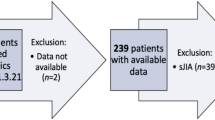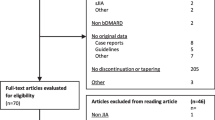Abstract
The primary aim of the treatment of juvenile idiopathic arthritis (JIA) is complete remission and minimizing the development of complications. Though biologic agents (BAs) provide better disease control, data related to BA switching patterns in JIA patients are scarce. This study aimed to determine the BA switching patterns in JIA patients. The study included children with JIA that received ≥ 1 BAs. Disease activity was evaluated based on the juvenile arthritis disease activity score 71 (JADAS71). Demographic data, clinical and laboratory findings, BA switching patterns, and the rationales for BA switching were recorded. The study included 177 (82 female and 95 male) JIA patients that received ≥ 1 BAs. Mean age at diagnosis of JIA was 9.1 ± 4.9 years. BAs were prescribed a median of 14 months (range: 3–66 months) after diagnosis. Among the 177 patients, 31 (17.5%) required BA switching a median 10.5 months (range: 3–38 months) after initiation of the first BA. Among all the BAs that were switched to after administration of the first BA, tocilizumab was the most commonly switched (n = 15). The most common reason for BA switching was inadequate response (n = 29). BAs were switched 2 times in 5 patients and 3 times in 1 patient. When patients that switched BAs 1 time were compared to those that switched 2 and 3 times there were not any differences in terms of JIA types, whereas those that switched 2 and 3 times had a higher active joint count and JADAS71 score after 6 months of initiation of the first BA. As some of the JIA patients could not achieve remission despite using the prescribed BA, BA switching was required. Herein, we provide data on both BA switching patterns and requirements, which may improve the management of JIA patients.
Similar content being viewed by others
Availability of data and material
The data underlying this article will be shared upon all reasonable requests to the corresponding author.
Code availability
Not applicable.
References
Minden K, Niewerth M, Listing J, Zink A, German Study Group of Pediatric R (2002) Health care provision in pediatric rheumatology in Germany–national rheumatologic database. J Rheumatol 29:622–628
Petty RE, Southwood TR, Manners P et al (2004) International League of Associations for Rheumatology classification of juvenile idiopathic arthritis: second revision, Edmonton, 2001. J Rheumatol 31:390–392
Ringold S, Weiss PF, Beukelman T et al (2013) 2013 update of the 2011 American College of Rheumatology recommendations for the treatment of juvenile idiopathic arthritis: recommendations for the medical therapy of children with systemic juvenile idiopathic arthritis and tuberculosis screening among children receiving biologic medications. Arthritis Rheum 65:2499–2512
Beukelman T, Patkar NM, Saag KG et al (2011) 2011 American College of Rheumatology recommendations for the treatment of juvenile idiopathic arthritis: initiation and safety monitoring of therapeutic agents for the treatment of arthritis and systemic features. Arthritis Care Res (Hoboken) 63:465–482
Quartier P (2016) Choice of biologic drug among children with juvenile idiopathic arthritis. Rheumatology (Oxford) 55:1534–1535
Ringold S, Angeles-Han ST, Beukelman T et al (2019) 2019 American College of Rheumatology/Arthritis Foundation Guideline for the Treatment of Juvenile Idiopathic Arthritis: therapeutic approaches for non-systemic polyarthritis, sacroiliitis, and enthesitis. Arthritis Care Res (Hoboken) 71:717–734
Consolaro A, Ruperto N, Bazso A et al (2009) Development and validation of a composite disease activity score for juvenile idiopathic arthritis. Arthritis Rheum 61:658–666
McErlane F, Beresford MW, Baildam EM et al (2013) Validity of a three-variable Juvenile Arthritis Disease Activity Score in children with new-onset juvenile idiopathic arthritis. Ann Rheum Dis 72:1983–1988
Consolaro A, Ravelli A (2016) Defining criteria for disease activity states in juvenile idiopathic arthritis. Rheumatology (Oxford) 55:595–596
Cimaz R, Maioli G, Calabrese G (2020) Current and emerging biologics for the treatment of juvenile idiopathic arthritis. Expert Opin Biol Ther 20:725–740
Poddighe D, Romano M, Gattinara M, Gerloni V (2018) Biologics for the treatment of juvenile idiopathic arthritis. Curr Med Chem 25:5860–5893
Marchesoni A, Zaccara E, Gorla R, Bazzani C, Sarzi-Puttini P, Atzeni F, Caporali R, Bobbio-Pallavicini F, Favalli EG (2009) TNF-alpha antagonist survival rate in a cohort of rheumatoid arthritis patients observed under conditions of standard clinical practice. Ann N Y Acad Sci 1173:837–846
Kearsley-Fleet L, Davies R, De Cock D, Watson KD, Lunt M, Buch MH, Isaacs JD, Hyrich KL, Group B-RC (2018) Biologic refractory disease in rheumatoid arthritis: results from the British Society for Rheumatology Biologics Register for Rheumatoid Arthritis. Ann Rheum Dis 77:1405–1412
Todoerti M, Favalli EG, Iannone F et al (2018) Switch or swap strategy in rheumatoid arthritis patients failing TNF inhibitors? Results of a modified Italian Expert Consensus. Rheumatology (Oxford) 57:42–53
Mannion ML, Xie F, Horton DB, Ringold S, Correll CK, Dennos A, Beukelman T, Investigators CR (2020) Biologic switching among non-systemic juvenile idiopathic arthritis patients: a cohort study in the childhood arthritis and rheumatology research alliance registry. J Rheumatol. https://doi.org/10.3899/jrheum.200437
Kearsley-Fleet L, Heaf E, Davies R et al (2020) Frequency of biologic switching and the outcomes of switching in children and young people with juvenile idiopathic arthritis: a national cohort study. Lancet Rheumatol 2:217–226
Otten MH, Prince FH, Anink J et al (2013) Effectiveness and safety of a second and third biological agent after failing etanercept in juvenile idiopathic arthritis: results from the Dutch National ABC Register. Ann Rheum Dis 72:721–727
Kasapçopur Ö, Barut K (2015) Treatment in juvenile rheumatoid arthritis and new treatment options treatments. Turk Pediatri Ars 50:1–10
Kubota T, Imanaka H, Takei S et al (2016) Disease activity score in 28 joints at 3 months after the initiation of biologic agent can be a predictive target for switching to the second biologic agent in patients with polyarticular juvenile idiopathic arthritis. Mod Rheumatol 26:358–361
Funding
No specific funding was received to carry out the work described in this article from any bodies in the public, commercial, or not-for-profit sectors.
Author information
Authors and Affiliations
Contributions
Conceptualization—SGK NAA; design of the work—SGK, FGD, RK, FC, HES, and NAA; data analysis—SGK, HES, NAA. All authors made substantial contributions to interpretation of data for the work. All authors were involved in drafting the article or critically revising it, and all authors approved the final version of the manuscript.
Corresponding author
Ethics declarations
Conflict of interest
The authors declare there are no conflicts of interest—financial or otherwise—related to the material presented herein.
Ethical approval
The study was conducted in accordance with Good Clinical Practice Guidelines and the Declaration of Helsinki, with the necessary approval of the local ethics committee (ethics approval number: KAEK/2019.01.06).
Informed consent
Informed consent was obtained from the patients’ legal guardians.
Consent for publication
The patients’ legal guardians provided written informed consent regarding publishing their data.
Additional information
Publisher's Note
Springer Nature remains neutral with regard to jurisdictional claims in published maps and institutional affiliations.
Rights and permissions
About this article
Cite this article
Karadağ, Ş.G., Demirkan, F.G., Koç, R. et al. Approach to switching biologics in juvenile idiopathic arthritis: a real-life experience. Rheumatol Int 42, 141–147 (2022). https://doi.org/10.1007/s00296-021-04854-y
Received:
Accepted:
Published:
Issue Date:
DOI: https://doi.org/10.1007/s00296-021-04854-y




